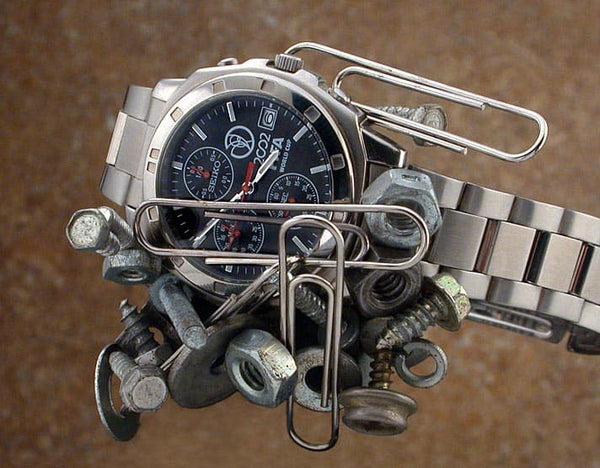How to Regulate Your Mechanical Watch
Owning a mechanical watch is fun for watch enthusiasts. At namokiMODS, we focus on Seiko Mod Watches and watch spare parts. With our parts catalog, we can help you make an incredible SKX007 mod.
However, you also need to know that your watches and their mechanical movements require attention and maintenance to give the best possible accuracy. Let’s look at what matters from a mechanical point of view.
What is a Watch Regulation?
Watch regulation corrects a watch movement when it is running fast or slow. Your watch should be within a minute per day, and even more accurate for most Seiko models. For reference, the accuracy of the popular modding calibre NH35 runs at -20 to +40 seconds per day.

Source: Wikibooks
This separates “regulation” from “adjustment”, which refers to the work done to a watch when it runs at a different rate under different conditions.
Adjustment is much more complicated than regulation, therefore, if you are non-professional, you should not attempt it – leave it to the watchmakers.
If you notice that your watch seems to be gaining or losing time consistently, it might be time for regulation. With some knowledge and a little bit of equipment, you can regulate your watch, but you also need to keep in mind that you must be extremely careful as you are manipulating the inside of the movement.
One major slip-up could mean the death of your watch movement – so let’s be careful.
What Causes An Inaccurate Movement
Before learning how to regulate your watches, let’s take a look at the common causes of an inaccurate movement.
The first reason is that your watch could be magnetized. With the pervasiveness of electronic products nowadays, magnetism is the no.1 cause of inaccuracy.
A movement is exposed to magnetic influence if you place your watch near an electronic product, like your cellphone, for a significant amount of time. A watch has probably been magnetized if it runs exceedingly fast, but it may also be slow in some cases.

Source: Worn and Wound
In addition, your watch movement requires cleaning. Any foreign elements caught in the gear train of the movement, such as small debris, tiny strands of fiber, or even hair, can slow down or even stop the movement.
As such, it is necessary to maintain a clean working environment as well as always wear finger cots.
Another cause is a mechanical shock. A mechanical movement works by the movement of its mechanical parts. A drop can cause your calibre to be faulty. Some of these parts, like the levers, are especially susceptible to external force as they are movable. The accuracy of the movement also can be affected if these parts are moved.
Why Do You Need A Timegrapher?
Although there are multiple ways to regulate a watch, the proper way to diagnose and regulate a watch is by using a timegrapher.
A timegrapher tells you more than just the accuracy of a watch. It picks up the ticks and tocks of the watch and calculates indicators of the general health of the movement through the built-in microphone.
When the timegrapher is running, it’ll show 4 numbers on the screen, including Rate, Amplitude, Beat error, and Parameters. Each number tells you an important piece of information about the condition of the watch.

Source: Vintage Watch Inc.
At that, the rate is the number that most people are looking for. Labeled in s/d, it gives you the time error in seconds per day.
Meanwhile, amplitude shows how much rotation is in one full swing of the balance wheel, which is important information in determining the health of the movement.
A healthy movement should have a high amplitude, in the range of 280-320. The maximum amplitude of a Japanese movement like Grand Seiko is in the range of 270-315 degrees, while an amplitude above 230 is considered acceptable.
A low amplitude generally indicates problems that need to be fixed before regulation, such as obstruction due to foreign elements, and oil drying up. Otherwise, anything above 250 degrees can still be considered a healthy amplitude.
A beat error, in simple terms, is the time difference between the “tick" and the “tock”. Normally they should be of equal length.

Source: Watch Repair Talk
However, if the balance wheel swings more in one direction and less in the other, one tick will be longer than one tock. An exceedingly high beat error also can cause a problem called “rebanking” or even stop a movement.
To set up a timegrapher, by default setting, you will only need to enter the lift angle, which depends on the model of the movement. The beat rate is by default set to “auto” and should be left as is which helps the timegrapher to detect the beat rate automatically.
Now that you know a bit more about movements – let’s look at how to regulate a watch.
Step by Step Guide to Regulate A Watch
To get started, you will need to wind the watch until it’s fully wound, and place the watch between the timegrapher clamp to start reading. The built-in microphone will pick up the movement of the watch and report its stats.
Two lines will be output on the screen. If it shows the lines slanting upward, the watch is running fast. On the other hand, if they are downward, it is running slow.
The distance between the lines represents beat error. The closer the lines are, the lower the beat error. If the lines are irregular, there is a greater problem. In this case, you should get the watch to a professional watchmaker for a deep check-up.
Secondly, if the lines are straight and consistent, you can turn to check the amplitude, which should be in the range of 280-320 when full wound.
Next, check the beat error. A beat error lower than 0.6ms is acceptable. When adjustment is needed, you can open the case back to access the back of the movement.
You should see two levers on top of the balance wheel: One lever is attached to the end of the hairspring, called the mobile stud carrier, and one is somewhere near the end of the hairspring, called the regulator.
To change the beat error, you will want to move the stud carrier. You will need a pair of tweezers for this to move the stud carrier until the beat error comes into an acceptable range.
Then, you can move to the rate.
Move the regulator to change the rate. There is a + / - indication on the movement to show you which direction to move the lever to. To gain time, move it toward +, and - to lose time. A rate between 0 and +10 sec per 24 hours is pretty good.
Finally, close the case back and check the movement again in the dial-up position. Regulation is complete!
We Have All The Parts You Need
If you love Seiko mods, you already know that we have some of the best watch mod parts in the market. Not only do we offer great aftermarket parts, we can also help you with Seiko spare parts, like a new watch movement.
Happy modding!
